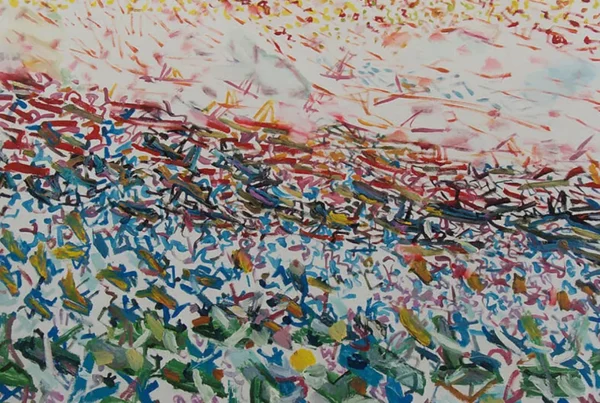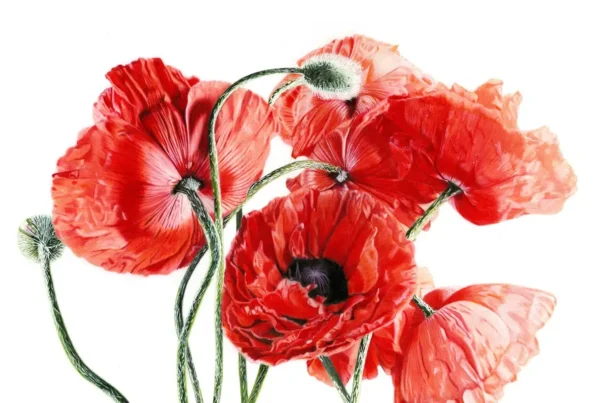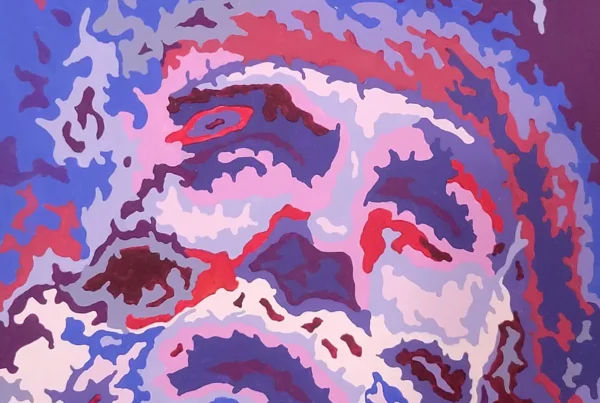“It wasn’t that I chose to be an artist, it’s that I had to be an artist, because there is nothing else I want to do.”
The Sanctuary of Art Behind Bars
Nathan Paddison hails from the bustling heart of Sydney, Australia’s western suburbs, an area renowned for its intricate network of gangs. For the majority of his life, Paddison was deeply entrenched in this tumultuous underworld, a journey that led him behind bars. Within the cold, stark confines of the prison, however, Paddison found an unexpected sanctuary – the art of painting.
Paddison devoted two years to honing his artistic skills while incarcerated, a period that not only saw him engage with the canvas but also marked the beginning of his transformative journey. Upon his release, his painting style underwent a profound metamorphosis. The cumulative experience of his twelve-year prison sentence, interlaced with the raw impressions of his gang-related past, imparted a unique, compelling voice to his artwork.
The vicissitudes of Paddison’s unconventional lifestyle fostered a newfound appreciation for life’s simpler, finer aspects, which is vividly reflected in his work. The artist’s brush now moves with an untamed freedom on the canvas, mirroring the exhilarating liberation he savours after years of confinement. Through his artwork, Paddison aims to resonate with his audience, his paintings serving as a poignant testament to his personal journey of redemption and rebirth.

Surrendering to the Irresistible Pull of Colors
Drawn magnetically towards the vivid spectrum of hues on his palette, Nathan Paddison found his true calling amidst streaks of oil and acrylic. The transformation was profound, as if a dormant persona within him had been resuscitated through the artistry of his strokes. Embarking on this creative journey, Paddison was not simply choosing a vocation – he was surrendering to an irresistible, innate pull. The canvas and colors were more than just his medium; they were his means of communication, his way of life, and the lens through which he perceived the world.
Paddison’s artistic approach might best be characterized as a form of self-expressionism, though he himself struggles to articulate its nuances. His technique is not confined within the borders of a single style. Rather, he enjoys exploring a multiplicity of stylistic territories, guided by the intimate dialogue he maintains with his canvas. This metaphysical connection dictates the canvas’s necessities, from the specific dimensions and orientation to the very heartbeat of its future image. For Nathan Paddison, the blank canvas is not a void to be filled, but a companion that whispers to him the secrets of its ultimate form.

Balancing Chaos and Creativity in the Studio
Within his studio, Nathan Paddison thrives amidst what many might perceive as chaos, yet he uniquely transforms into a source of balance. Amid the tools of his trade, one might spot an unusual array of objects: a refrigerator stocked with chocolates, a skateboard, and even a set of weights. These are not just novelties or random personal effects. For Paddison, they act as deliberate distractions, purposefully interspersed throughout his workspace to counterbalance his ceaseless urge to paint. Left unfettered, Paddison admits that his passion for painting could likely yield a staggering million works of art.
The creative oeuvre of Paddison takes inspiration from several art-world luminaries. Four names stand out in his pantheon of artistic influences: Willem de Kooning, Cy Twombly, Jean Michel Basquiat, and Joan Mitchell. Each of these iconic artists, through their distinctive styles and creative narratives, has significantly shaped the way Paddison approaches his craft.
Among Paddison’s extensive body of work, one piece occupies a particularly special place in his heart and home. Titled “Are Far There’s Love,” this abstract work encapsulates a pivotal moment in the artist’s life: the day he discovered that he was to become a father to a daughter. Infused with a profound sense of personal emotion, the painting serves as a tangible representation of Paddison’s journey, not just as an artist, but also as a father, bridging the gap between his personal and professional realms.

Influences and Inspirations: Shaping Paddison’s Artistic Voice
Nathan Paddison primarily employs acrylic paint due to its rapid drying time, which allows him to engage in prolific painting sessions. While he has the capacity to work on up to ten canvases simultaneously, he typically focuses on creating three or four pieces concurrently. The artist abstains from utilizing oil paint, as he lacks adequate space for proper drying. Aspires to venture into oil painting in the future, Paddison plans to do so once he procures a sufficiently expansive studio. In his artistic practice, Paddison ventures beyond acrylic paint, incorporating a diverse array of mediums, including oil, stick, acrylic, spray paint, charcoal, pencil, collage, wax crayon, and marker. A steadfast proponent of artistic exploration, he eagerly embraces new mediums, always seeking to expand the boundaries of his creative expression.
Nathan Paddison harbors two distinctive visions for future exhibitions that encapsulate his aspirations. Firstly, he envisions a collaborative showcase with his daughter, poised to transpire when she attains the ability to draw and paint proficiently, around the age of four or five. This envisioned series would manifest as a heartfelt amalgamation of their artistic prowess. Secondly, Paddison yearns to curate an exhibition reminiscent of the enchanting world of Alice in Wonderland. Conjured within this captivating display would be a surreal environment, adorned with synthetic grass, colossal mushrooms, and an abundance of peculiar objects. Through these ambitious endeavors, Paddison endeavors to craft immersive experiences that captivate and transport viewers into realms of imagination and wonder.






